The Rise and Fall of the
Amateur New York Subway Riding Committee
Copyright © 1980, Peter R. Samson
(to home page)
“A Flushing youth, who wanted his money’s worth, rode
all lines of the subway on a single token. With doubling back as
needed, the trip totaled over 400 miles — more than the train
journey from New York to Pittsburgh. It took him 25 hours and 36
minutes.”
Things seemed a little dull at M.I.T. during the spring break,
1966, when my eye fell upon the above squib from the back of a New
York subway map. Oh boy! What a hack! Well, I thought, maybe we can
work the computer at the Artificial Intelligence lab into it
somehow as well. It all seemed natural, since four of us at AI were
partners in a rent-controlled flat on the lower east side. So I
wrote up a bunch of LISP functions based on (ahem) Samson’s
Rule of the New York subway: travel takes one minute per station,
plus one-half minute per stop, plus five minutes to cross the East
River, plus one minute to change platforms, plus five minutes (in
the daytime) for a train to come. There was also a function to find
a minimum-transfer path from any station to any other. At the same
time I worked out (by hand) a route based on all the subway lines
shown on the map. The LISP was used to simulate following the route
through the system, so I came up with a rough estimate: 25 hours
and a half.
The major complication in planning the route was that certain lines
only ran at certain hours: the M (Nassau Loop) in particular had
only two trains northbound in the a.m. rush hour and three
southbound in the p.m. For another example, there is a section of
line used by the Rockaway Shuttle (HH train) only between midnight
and 4 a.m. To get the details of all of these, including first and
last train times, required some visits to the Transit Authority
headquarters. These visits aroused the interest of the TA’s
public relations people, who the day before our run started
spreading the word to newspapers and television stations.
After an incomplete night’s sleep and a 6:30 a.m. rendezvous
at Hong Fat, we started off to the Pacific Street station in
Brooklyn to commence the run. (Why Pacific Street? Well, a guy who
lived in that neighborhood said he’d join us there.... He
didn’t.) Our party was six in number: myself, George
Mitchell, Andy Jennings, Jeff Dwork, Dave Anderson, and Dick Gruen.
Gruen kept a log, which started as follows:
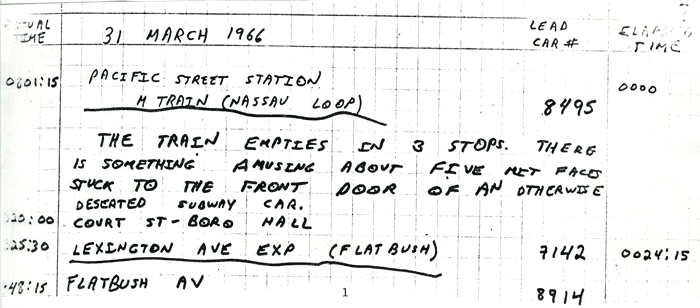
There were various embarrassments. I got left behind once and
everyone else had to wait at the next transfer point since I had
the route. Later (after copies of the route were passed around)
Mitchell, Anderson, and Jennings got left behind in a men’s
room; then they got off at the wrong (dead end) platform of the
145th Street–Lenox Avenue station and had to pay extra fares
to come back; finally they caught up. There were gratifying moments
too. TA policemen at South Ferry and at Coney Island asked for our
schedules, and were seen radioing them in to HQ. A New York Post
reporter joined us for a while on the A train to 205th Street,
getting our candid responses to questions such as “What do
you have against the subways?” and “Have you picked up
any girls?” Finally, about half an hour later than the
initial prediction, we pulled into a platform at Pelham Bay Park
that was jammed full of reporters and cameramen.

Then came a dimly-remembered series of photos and interviews. One
question, however, stood out: how come we didn’t do as well
as Geoffrey Arnold had? Who? we replied. It turned out that a
fellow by that name some years before had done a similar run, but
in less time. We had no idea, however, what he had
meant by “covering the entire subway system,” so the
two runs were not strictly comparable (and likewise for the case of
the Flushing youth.) There followed a lunch on the TA and a very
long nap.
I decided that this sport was being held back by the lack of an
organized rule-making body. So I got in touch with Geoffrey Arnold,
then a student at Harvard, and with his encouragement Gruen and I
developed a set of rules which I then prevailed upon the Transit
Authority to take as gospel.
Regulations Regarding Amateur New York Subway Riding
Definitions
- This document sets forth the rules of the competition
with the name “Amateur New York Subway
Riding.”
- There are three Classes of Competition:
- Class A: Covering all Lines
- Class B: Touching all Stations
- Class C: Passing all Stations
- In general, the object of the competition is to set a
record minimum time for a given Class of Competition by
- planning a route through the New York City Transit
System subject to the qualifications of that Class; and
- making a timed run over that route.
- These rules, and all records of the competition, are
maintained by the Amateur New York Subway Riding Committee,
referred to herein as the Committee.
- Each person who intentionally participates in the run,
or who attempts specifically to expedite the run by his actions
during the run, or who participates in the selection of lines and
stations to be followed during the run, is considered a contestant
with regard to that run.
- The phrase “Transit Authority” as used
herein refers to the New York City Transit Authority and to its
successors.
- A segment of right-of-way is defined as:
- a group of one or more tracks
- all used by scheduled passenger revenue traffic,
and
- all running roughly parallel for the length of the
segment, and
- no two of which are separated laterally by a distance
greater than one hundred feet;
- having at each end a station either
- where a passenger may transfer free of charge between
trains running on any tracks of the segment, or
- which is at One Hundred Forty-fifth Street and Lenox
Avenue.
- A station is defined as that represented by any single
station-designating area on the map portion of a current
“Official New York Subway Map and Station Guide,”
except that Jay–Borough Hall and Bridge–Jay are two
distinct stations.
- A station is said to be included in a segment of
right-of-way if
- it is between the end stations of the segment, or is
itself either end station, and
- scheduled passenger revenue traffic on one or more
tracks of the segment stops at the station.
- A platform group is defined as a set of platforms at a
station such that there is a segment of right-of-way which includes
the station, and trains over that segment can be either boarded or
departed, or both, at each platform in the platform group.
General Rules
- All contestants are expected to display good
sportsmanship, and to commit no mischief or criminal act while
engaged in this competition.
- No contestant may at any time affect, or attempt to
affect, the operation during the time of the run of any train,
signal, or other part of the Transit Authority system by
communicating to any employee of the Transit Authority any
statement which the contestant does not know to be true, or by
suggesting to any such employee the reason for travel of any person
aware of the run.
- No present or recent employee of the Transit Authority
may be a contestant.
- Each contestant making the run must pay one token fare
upon entering the Transit Authority system prior to the run, and
until the completion of the run must pay no further fare nor
reenter premises of the Transit Authority by fraudulent means, or
be means of any sort of pass.
- During the run, no contestant may enter upon any
property of the Transit Authority, nor travel on any Transit
Authority vehicle, which is not open to ordinary passengers at that
time.
- During the run, a log must be kept, containing
unambiguously the following information describing the run:
- each station where the contestants making the run
changed trains, and the stations at the beginning and end of the
run;
- the number of some car, preferably the first, in each
train taken in the run, and the name and destination of the
train;
- each location where a train being taken in the run
reversed direction, or turned around a loop; and
- the times, measured to the nearest half-minute, of the
following events at the beginning and end of the run, and at each
change of trains during the run:
- the first opening, subsequent to arrival, of the doors
of the train being departed;
- the last closing, prior to departure, of the doors of
the train being boarded.
- Such information must be essentially in the order of
occurrence of the events described.
- Subsequent to the run, if a contestant wishes the run
to be considered for a record, he should submit to the Committee a
document containing the following:
- a copy of the log;
- the Class of Competition for which entry is
desired;
- a list of all contestants in the run, distinguishing
those who made the run from those who did not, and giving their
names and home addresses;
- a description of the timekeeping equipment used on the
run, and of the means used of determining its accuracy;
- the statement “I certify that to the best of my
knowledge and belief the information described herein is correct,
and the run described herein was accomplished in accordance with
all rules applicable to Class (A or B or C) of Competition,”
signed and dated by each of the contestants.
Qualifications for Class A
- During the run, the contestants making the run must
traverse completely at least once each segment of right-of-way of
the Transit Authority system. Each segment may be traversed either
in one continuous transit or in any number of partial transits
between stations on the segment.
Qualifications for Class B
- During the run, the contestants making the run must,
for each platform group in the Transit Authority system, at least
once either
- board a train from a platform in that platform group,
or
- depart from a train at a platform in that platform
group, or
- pass through that station on a train which stops to
load or discharge passengers at a platform in that platform
group.
Qualifications for Class C
- During the run, the contestants making the run must,
for each station in the Transit Authority system, at least once
either
- board a train at that station, or
- depart from a train at that station, or
- ride a train over a segment of right-of-way which
includes that station.
These rules deserve some comment, especially now, years after their
writing in 1966. Rule II: It proved impossible to come up with a
single definition of “covering the entire system” that
everyone would agree to. Therefore three distinct definitions were
chosen, with corresponding Class definitions. Class A was planned
to be the most time-consuming, and Class C the least. Rule IV: The
work of the Committee was in fact done by me as Secretary. Its
other members were Geoffrey Arnold and Mr. Don Harold of the TA.
Rule VII: A lot of effort went into this definition in order to make
it agree with our intuitive feeling of when two tracks are part of
the same right-of-way and when they are different. Nowadays two
changes would be in order. The qualification in VII.A.1 would have to
read “all used by scheduled non-extra-fare passenger revenue
traffic” to avoid complications caused at various times by
the JFK express and the Aqueduct special. Paragraph VII.B.2 has
become unnecessary since the Lenox Avenue line now extends to a
proper terminal at 148th Street. Rule VIII: The name of the map has
since changed several times, and Bridge–Jay disappeared with
the razing of the Myrtle El. Rules XII and XIII: While these rules
were being written, there was a well-publicized record run by a boy
scout troop, including its scoutmaster, a TA employee; reliable
sources reported that motormen were urged to hurry up, etc. during
the run, as a favor to the scoutmaster, to improve their time.
Hence rules XII and XIII, and the emphasis on amateur
competition. Rule XIV: In perpetual memory of the Flushing youth,
who wanted his money’s worth. Rule XVI: The car numbers are
required to verify the authenticity of the log; times are measured
to the half minute because the TA operating timetables are. Rule
XVIII: Here is Class A, Covering all Lines, defined as traversing each
and every distinct segment of right-of-way that passengers
can travel over, even if one must be there at exactly the
right time of day to do it. This is essentially what we had meant
to do in our run. There happened to be a fairly straightforward
algorithm for computer searching through the various routes that
fit this definition. Rule XIX: This is for Class B; it requires
stopping at every station, and at every part of a complex station.
Times Square station, for example, at that time had four platform
groups: BMT Broadway line, IRT Seventh Avenue line, Forty-second
Street Shuttle, and the Flushing line. Rule XX: The rule for Class
C. This simply requires passing through some part of each station.
As a consequence, it is the fastest class, with the result that
most groups picked it for their runs.
Work proceeded in earnest on a real computer-directed Class A
run.

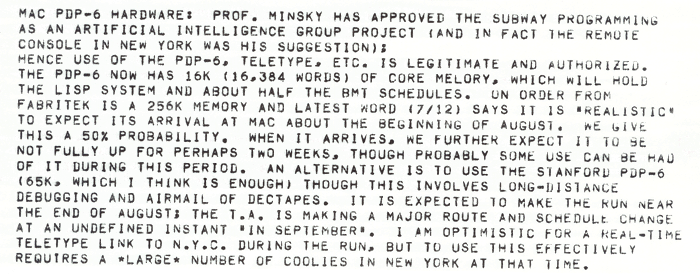
In fact we were nowhere near ready before September, and the work
of coding and checking schedules for the computer continued through
the winter and into 1967. At the same time I attacked the
logistical problems of getting information to and from the people
making the run. A vast array of documents appeared: train lists,
station lists, station maps (see following), message delivery
forms, telephone logs, and an Operations Manual.
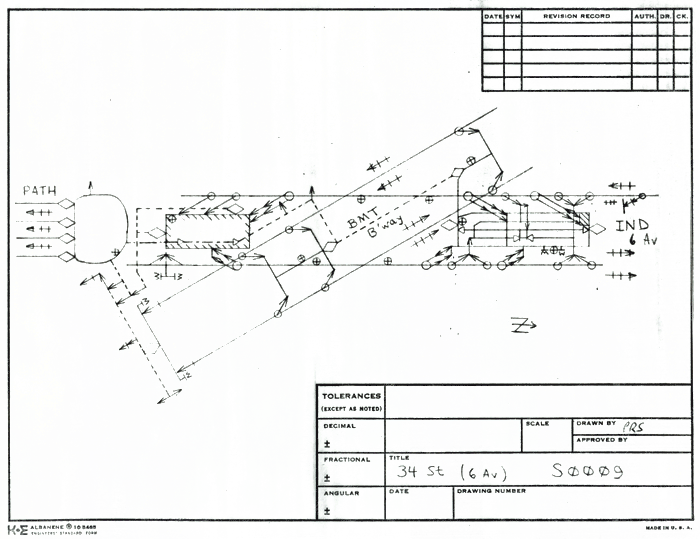
A couple excerpts
from the Operations Manual follow: the first is from Section IV
— Overview and the second from Section VI —
Communications.
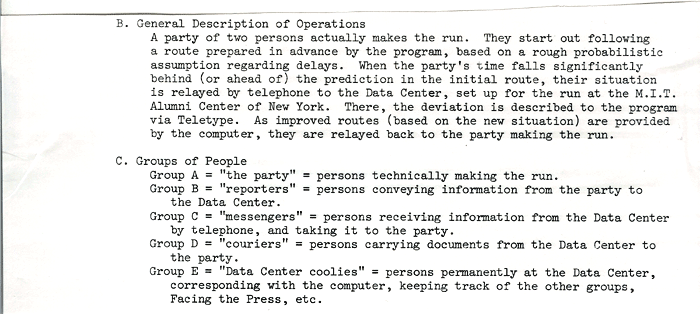
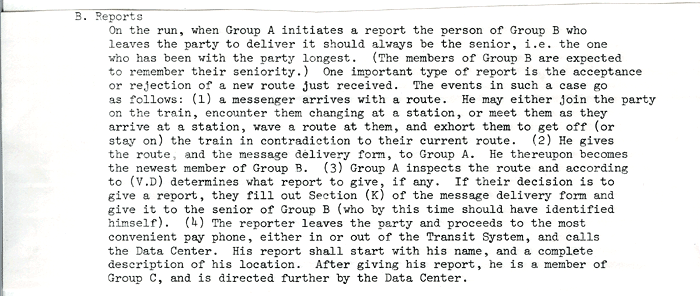
At last the big day came: April 19, 1967. (There had been a brief
dress rehearsal one week earlier.) A party of two — George
Mitchell and Andy Jennings — were to make the run. Three
persons, including myself, were at the Data Center. It was arranged
that someone would be on hand at the computer at M.I.T. at all
times during the run. And to convey information to and from the
party were various volunteers; their number fluctuated between four
and eight depending on the time of day or night. All was in
readiness; the telephones, Teletype, maps, and clocks were in place
at the Data Center; messengers were positioned at key nodes ahead
of the run; and at 2:43 p.m. the party set off from 168th Street
station on the Jamaica El and the run was on.
Things went smoothly at first. Then, at 5:32 p.m., three things
happened.
- The computer at M.I.T. bombed out (parity error in
the Fabritek memory).
- One of the runners, dispatched to the junction
station at Prospect Park to tell the party to change their route at
that point, called in to say he had missed his stop and to ask how
to get back there.
- A report came in that the party had caught the
third (and last) p.m. M train instead of the second, as had been
hoped, and that furthermore their M train was running
late.
From then on it was clear that our luck was not going to be good,
and that the principal effort would be to keep from falling further
behind.
Minor triumphs and minor setbacks continued through the night,
slightly more of the latter than the former. The logistical aspects
worked remarkably well. Brian Harvey, one of the messengers, later
expressed his astonishment. He was standing by a pay phone in a
random subway station in the middle of the night; he received a
call to take certain information to a station where he had never
been before, in deepest Bushwick; he was told that the party would
come through on a certain train at a certain time; and they did,
and he actually met them there. The start and finish of the log,
kept by Andy Jennings, read as follows.
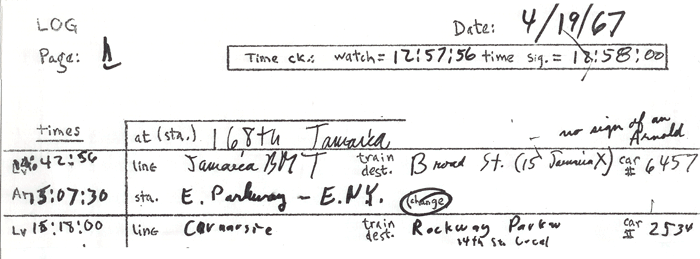

So the run ended, having taken (adjusting for watch error) 25 hours
and 50 1/2 minutes. This was only 7 minutes less than our original
run, but for the first time a run had been made that covered every
segment of right-of-way of the subway system. It was also the first
Class A run according to agreed-upon and officially sanctioned
rules. (Subsequent contestants usually went for Class C, which
promised the shortest overall times.)
Later I boiled the computer route down to one with a fixed set of
alternatives which could be chosen by hand on the spot. From time
to time that summer when I visited New York I would run that route,
more or less, up to the point when some gross mischance would make
it hopeless to go on. Once, for instance, the northbound Broadway
Express I was on hit a derelict wandering on the subway tracks
between Eighth Street and Union Square. Another time I made a
fantastically good transfer late at night — and immediately
got stuck behind the Sperry Rail Service car.
That route (and all our computerized schedules) became obsolete
November 26, 1967, when the Chrystie Street connection went into
service, but our adventures then, and a description of the Subway
Game, is another story. And what of the Flushing youth? His name is
Jerome Moses, and the last I heard he was a bus dispatcher at the
Port Authority terminal in New York.








